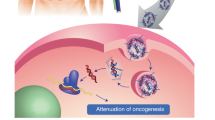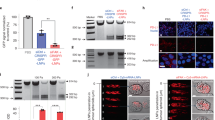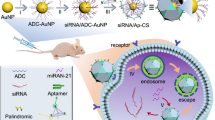Abstract
The therapeutic potential of miRNA (miR) in cancer is limited by the lack of efficient delivery vehicles. Here, we show that a self-assembled dual-colour RNA-triple-helix structure comprising two miRNAs—a miR mimic (tumour suppressor miRNA) and an antagomiR (oncomiR inhibitor)—provides outstanding capability to synergistically abrogate tumours. Conjugation of RNA triple helices to dendrimers allows the formation of stable triplex nanoparticles, which form an RNA-triple-helix adhesive scaffold upon interaction with dextran aldehyde, the latter able to chemically interact and adhere to natural tissue amines in the tumour. We also show that the self-assembled RNA-triple-helix conjugates remain functional in vitro and in vivo, and that they lead to nearly 90% levels of tumour shrinkage two weeks post-gel implantation in a triple-negative breast cancer mouse model. Our findings suggest that the RNA-triple-helix hydrogels can be used as an efficient anticancer platform to locally modulate the expression of endogenous miRs in cancer.
This is a preview of subscription content, access via your institution
Access options
Subscribe to this journal
Receive 12 print issues and online access
$259.00 per year
only $21.58 per issue
Buy this article
- Purchase on Springer Link
- Instant access to full article PDF
Prices may be subject to local taxes which are calculated during checkout





Similar content being viewed by others
References
Kasinski, A. L. & Slack, F. J. MicroRNAs en route to the clinic: Progress in validating and targeting microRNAs for cancer therapy. Nature Rev. Cancer 11, 849–864 (2011).
Li, Z. & Rana, T. M. Therapeutic targeting of microRNAs: Current status and future challenges. Nature Rev. Drug Discov. 13, 622–638 (2014).
Yin, H. et al. Non-viral vectors for gene-based therapy. Nature Rev. Genet. 15, 541–555 (2014).
Conde, J., Edelman, E. R. & Artzi, N. Target-responsive DNA/RNA nanomaterials for microRNA sensing and inhibition: The jack-of-all-trades in cancer nanotheranostics? Adv. Drug Deliv. Rev. 81, 169–183 (2015).
Chen, Y. C., Gao, D. Y. & Huang, L. In vivo delivery of miRNAs for cancer therapy: Challenges and strategies. Adv. Drug Deliv. Rev. 81, 128–141 (2015).
Yin, P. T., Shah, B. P. & Lee, K. B. Combined magnetic nanoparticle-based microRNA and hyperthermia therapy to enhance apoptosis in brain cancer cells. Small 10, 4106–4112 (2014).
Hao, L. L., Patel, P. C., Alhasan, A. H., Giljohann, D. A. & Mirkin, C. A. Nucleic acid–gold nanoparticle conjugates as mimics of microRNA. Small 7, 3158–3162 (2011).
Endo-Takahashi, Y. et al. Systemic delivery of miR-126 by miRNA-loaded bubble liposomes for the treatment of hindlimb ischemia. Sci. Rep. 4, 3883 (2014).
Chen, Y. C., Zhu, X. D., Zhang, X. J., Liu, B. & Huang, L. Nanoparticles modified with tumor-targeting scFv deliver siRNA and miRNA for cancer therapy. Mol. Ther. 18, 1650–1656 (2010).
Anand, S. et al. MicroRNA-132-mediated loss of p120RasGAP activates the endothelium to facilitate pathological angiogenesis. Nature Med. 16, 909–914 (2010).
Wu, Y. et al. MicroRNA delivery by cationic lipoplexes for lung cancer therapy. Mol. Pharm. 8, 1381–1389 (2011).
Mittal, A., Chitkara, D., Behrman, S. W. & Mahato, R. I. Efficacy of gemcitabine conjugated and miRNA-205 complexed micelles for treatment of advanced pancreatic cancer. Biomaterials 35, 7077–7087 (2014).
Cheng, C. J. et al. MicroRNA silencing for cancer therapy targeted to the tumour microenvironment. Nature 518, 107–110 (2015).
Shu, D. et al. Systemic delivery of Anti-miRNA for suppression of triple negative breast cancer utilizing RNA nanotechnology. ACS Nano 9, 9731–9740 (2015).
McKiernan, P. J., Cunningham, O., Greene, C. M. & Cryan, S. A. Targeting miRNA-based medicines to cystic fibrosis airway epithelial cells using nanotechnology. Int. J. Nanomed. 8, 3907–3915 (2013).
Cheng, C. J. & Saltzman, W. M. Polymer nanoparticle-mediated delivery of microRNA inhibition and alternative splicing. Mol. Pharm. 9, 1481–1488 (2012).
Guo, P. X. The emerging field of RNA nanotechnology. Nature Nanotech. 5, 833–842 (2010).
Lee, J. B., Hong, J., Bonner, D. K., Poon, Z. & Hammond, P. T. Self-assembled RNA interference microsponges for efficient siRNA delivery. Nature Mater. 11, 316–322 (2012).
Mok, H., Lee, S. H., Park, J. W. & Park, T. G. Multimeric small interfering ribonucleic acid for highly efficient sequence-specific gene silencing. Nature Mater. 9, 272–278 (2010).
Lee, H. et al. Molecularly self-assembled nucleic acid nanoparticles for targeted in vivo siRNA delivery. Nature Nanotech. 7, 389–393 (2012).
Haque, F. et al. Ultrastable synergistic tetravalent RNA nanoparticles for targeting to cancers. Nano Today 7, 245–257 (2012).
Shu, D., Shu, Y., Haque, F., Abdelmawla, S. & Guo, P. X. Thermodynamically stable RNA three-way junction for constructing multifunctional nanoparticles for delivery of therapeutics. Nature Nanotech. 6, 658–667 (2011).
Jendis, J., Strack, B. & Moelling, K. Inhibition of replication of drug-resistant HIV type 1 isolates by polypurine tract-specific oligodeoxynucleotide TFO A. AIDS Res. Hum. Retroviruses 14, 999–1005 (1998).
Moelling, K., Abels, S., Jendis, J., Matskevich, A. & Heinrich, J. Silencing of HIV by hairpin-loop-structured DNA oligonucleotide. FEBS Lett. 580, 3545–3550 (2006).
Yoon, K., Hobbs, C. A., Walter, A. E. & Turner, D. H. Effect of a 5′-phosphate on the stability of triple helix. Nucleic Acids Res. 21, 601–606 (1993).
Chan, P. P. & Glazer, P. M. Triplex DNA: Fundamentals, advances, and potential applications for gene therapy. J. Mol. Med. 75, 267–282 (1997).
Holland, J. A. & Hoffman, D. W. Structural features and stability of an RNA triple helix in solution. Nucleic Acids Res. 24, 2841–2848 (1996).
Duca, M., Vekhoff, P., Oussedik, K., Halby, L. & Arimondo, P. B. The triple helix: 50 years later, the outcome. Nucleic Acids Res. 36, 5123–5138 (2008).
Foulkes, W. D., Smith, I. E. & Reis, J. S. Triple-negative breast cancer. N. Engl. J. Med. 363, 1938–1948 (2010).
Nassirpour, R., Mehta, P. P., Baxi, S. M. & Yin, M. J. miR-221 promotes tumorigenesis in human triple negative breast cancer cells. PLoS ONE 8, e62170 (2013).
Piovan, C. et al. Oncosuppressive role of p53-induced miR-205 in triple negative breast cancer. Mol. Oncol. 6, 458–472 (2012).
Conde, J., Oliva, N. & Artzi, N. Implantable hydrogel embedded dark-gold nanoswitch as a theranostic probe to sense and overcome cancer multidrug resistance. Proc. Natl Acad. Sci. USA 112, E1278–E1287 (2015).
Oliva, N. et al. Regulation of dendrimer/dextran material performance by altered tissue microenvironment in inflammation and neoplasia. Sci. Transl. Med. 7, 272ra211 (2015).
Schroeder, A., Levins, C. G., Cortez, C., Langer, R. & Anderson, D. G. Lipid-based nanotherapeutics for siRNA delivery. J. Int. Med. 267, 9–21 (2010).
Francois, J. C. et al. Sequence-specific recognition and cleavage of duplex DNA via triple-helix formation by oligonucleotides covalently linked to a phenanthroline copper chelate. Proc. Natl Acad. Sci. USA 86, 9702–9706 (1989).
Chiou, C. C., Chen, S. W., Luo, J. D. & Chien, Y. T. Monitoring triplex DNA formation with fluorescence resonance energy transfer between a fluorophore-labeled probe and intercalating dyes. Anal. Biochem. 416, 1–7 (2011).
Wan, C. H., Cui, M., Song, F. R., Liu, Z. Q. & Liu, S. Y. Evaluation of effects of bivalent cations on the formation of purine-rich triple-helix DNA by ESI-FT-MS. J. Am. Soc. Mass Spectrom. 20, 1281–1286 (2009).
Carlson, R. D., Olins, A. L. & Olins, D. E. Urea denaturation of chromatin periodic structure. Biochemistry 14, 3122–3125 (1975).
Ha, M. & Kim, V. N. Regulation of microRNA biogenesis. Nature Rev. Mol. Cell Biol. 15, 509–524 (2014).
Conner, S. D. & Schmid, S. L. Regulated portals of entry into the cell. Nature 422, 37–44 (2003).
Conde, J. et al. 15 years on siRNA delivery: Beyond the State-of-the-Art on inorganic nanoparticles for RNAi Therapeutics. Nano Today http://dx.doi.org/10.1016/j.nantod.2015.06.008 (in the press).
Kitchens, K. M., Kolhatkar, I. B., Swaan, P. W. & Ghandehari, H. Endocytosis inhibitors prevent poly(amidoamine) dendrimer internalization and permeability across Ceco-2 cells. Mol. Pharm. 5, 364–369 (2008).
Jones, A. T. Macropinocytosis: Searching for an endocytic identity and role in the uptake of cell penetrating peptides. J. Cell Mol. Med. 11, 670–684 (2007).
Linares, J. et al. Endocytic mechanisms of graphene oxide nanosheets in osteoblasts, hepatocytes and macrophages. ACS Appl. Mater. Interfaces 6, 13697–13706 (2014).
Iversen, T. G., Skotland, T. & Sandvig, K. Endocytosis and intracellular transport of nanoparticles: Present knowledge and need for future studies. Nano Today 6, 176–185 (2011).
Segovia, N. et al. Hydrogel doped with nanoparticles for local sustained release of siRNA in breast cancer. Adv. Healthc. Mater. 4, 271–280 (2015).
Sledge, G. W. et al. Past, present, and future challenges in breast cancer treatment. J. Clin. Oncol. 32, 1979–1986 (2014).
Sparano, J. A. et al. Weekly paclitaxel in the adjuvant treatment of breast cancer. N. Engl. J. Med. 358, 1663–1671 (2008).
Miller, K. et al. Paclitaxel plus bevacizumab versus paclitaxel alone for metastatic breast cancer. N. Engl. J. Med. 357, 2666–2676 (2007).
Oliva, N. et al. Natural tissue microenvironmental conditions modulate adhesive material performance. Langmuir 28, 15402–15409 (2012).
Acknowledgements
J.C. acknowledges a Marie Curie International Outgoing Fellowship and Funding (FP7-PEOPLE-2013-IOF, Project 626386). We thank D. Fulop for helpful and fruitful discussions. We thank the Swanson Biotechnology Center at the Koch Institute for Integrative Cancer Research at Massachusetts Institute of Technology (MIT) for assistance with animal experiments and facilities, especially the microscopy, flow cytometry, and histology cores. We also acknowledge that all qPCR experiments done in the KI Genomics Core/MIT BioMicro Center are funded by the NIH and supported in part by the Koch Institute Support Grant P30-CA14051 from the National Cancer Institute and by the National Institute of Environmental Health Sciences of the NIH under award P30-ES002109. We thank D. S. Yun for cryo-TEM assistance at the Peterson Nanotechnology Materials Core Facility. We thank the Department of Comparative Medicine at MIT, especially J. Haupt. We thank G. Paradis for FACS assistance with Cancer Center Support (FACS core) Grant P30-CA14051 from the National Cancer Institute. We thank P. Boisvert and Y. Zhang for technical assistance in SEM at the MIT Center for Materials Science and Engineering (CMSE). These SEM studies made use of the MRSEC Shared Experimental Facilities at MIT, supported by the National Science Foundation under award number DMR-1419807.
Author information
Authors and Affiliations
Contributions
J.C. and N.A. conceived the project and designed the experiments. J.C., N.O., H.S.S. and M.A. performed the experiments, collected and analysed the data. J.C. and N.A. co-wrote the manuscript. All authors discussed the results and reviewed the manuscript.
Corresponding authors
Ethics declarations
Competing interests
The authors declare no competing financial interests.
Supplementary information
Supplementary Information
Supplementary Information (PDF 5573 kb)
Rights and permissions
About this article
Cite this article
Conde, J., Oliva, N., Atilano, M. et al. Self-assembled RNA-triple-helix hydrogel scaffold for microRNA modulation in the tumour microenvironment. Nature Mater 15, 353–363 (2016). https://doi.org/10.1038/nmat4497
Received:
Accepted:
Published:
Issue Date:
DOI: https://doi.org/10.1038/nmat4497
This article is cited by
-
Rediscovery of poly(ethylene glycol)s as a cryoprotectant for mesenchymal stem cells
Biomaterials Research (2023)
-
The various role of microRNAs in breast cancer angiogenesis, with a special focus on novel miRNA-based delivery strategies
Cancer Cell International (2023)
-
A review on selenium and gold nanoparticles combined photodynamic and photothermal prostate cancer tumors ablation
Discover Nano (2023)
-
Immunization against Zika by entrapping live virus in a subcutaneous self-adjuvanting hydrogel
Nature Biomedical Engineering (2023)
-
Hydrogels for RNA delivery
Nature Materials (2023)



